Where Can I Download Os X El Capitan
More than Mac mania
The evolution of macOS (and Mac OS X)
Apple's desktop operating system, macOS, has been the staple crop for its iMacs and MacBooks. Here we go back to where it all began in 2001 (when it was known equally Mac Bone X).
![Computerworld > The Evolution of Mac OS X / macOS [cover]](https://images.idgesg.net/images/article/2018/09/cw_evolution_of_os_x_macos_01-100770742-large.jpg?auto=webp&quality=85,70)
IDG / Apple
Progression of macOS
On March 24, 2001, Apple released the outset version of its Mac Os X operating system, noteworthy for its UNIX architecture.
Os X (now macOS) has been known over the years for its simplicity, aesthetic interface, advanced technologies, applications, security and accessibility options. From the Finder to Spotlight, the Dock to iCloud, the operating system has been integrated into Apple tree'due south hardware, as well as iOS devices, so users tin can easily work and navigate. (And every bit of Big Sur, it works on Apple tree Silicon.)
OS X/macOS has get a brand identity for both Apple and its Mac lineup and has broadly evolved over the years, even taking some of its shape from Apple'southward after launch of iOS, its mobile operating organisation.
Hither'southward a await at the progression of Bone X from its debut in 2001 to the current version (as macOS) released in 2020. (At that place's also a peek at the upcoming macOS "Monterey.")
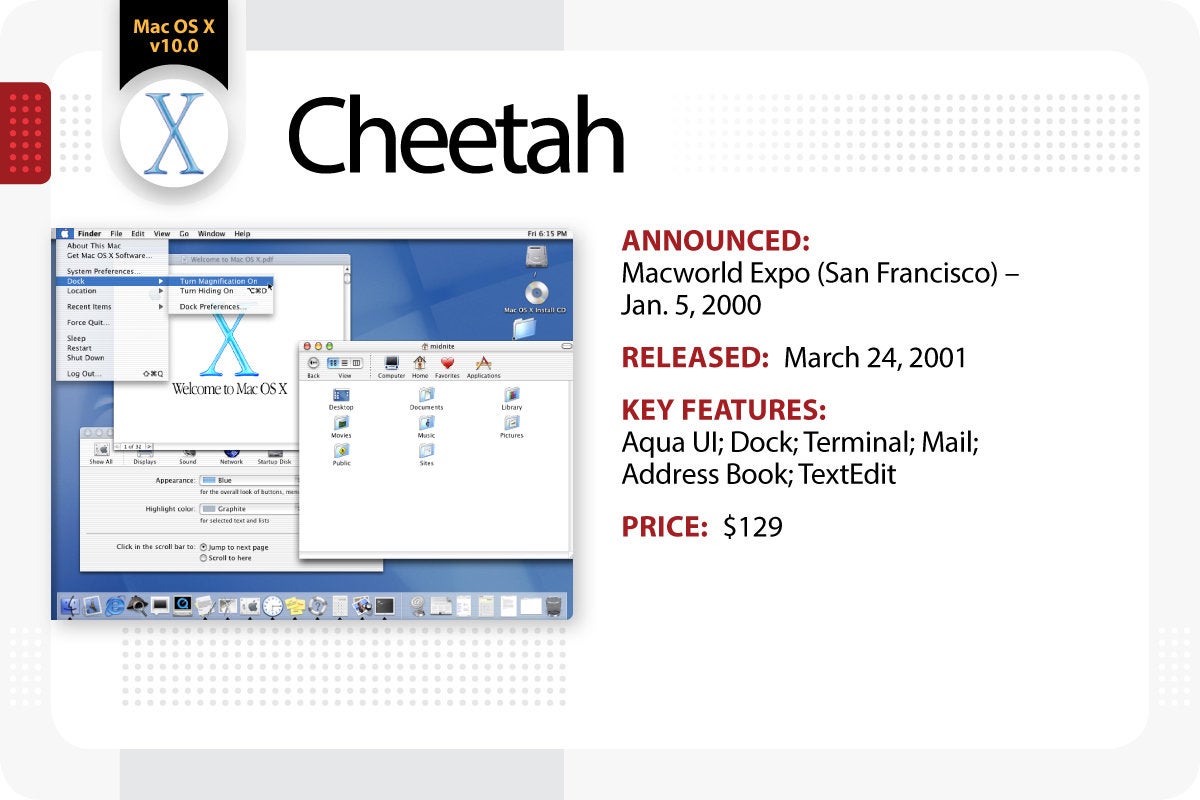
IDG / Apple tree
Cheetah
Apple's get-go major Os X release, known every bit Chetah, was a radical change from the previous Mac Bone nine, Apple tree's Archetype Operating System. Announced at the 2000 Macworld Expo in San Francisco, Mac Os 10 10.0 introduced the new Aqua User Interface, which showcased title confined with a brushed metal expect, brightly colored buttons on windows and photo-realistic icons. Bone X Cheetah too debuted the dock that still gives modern Macs their notable advent. New apps were included as well, such every bit Mail, Address Book and TextEdit.
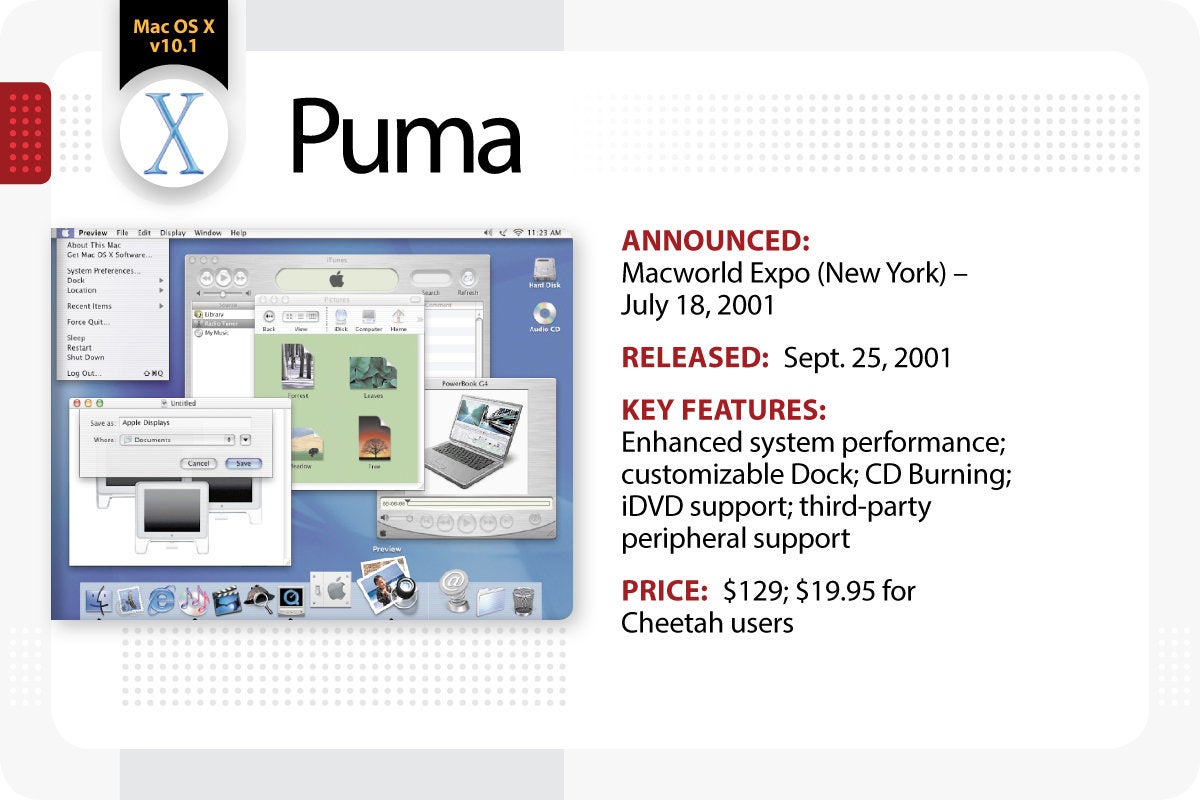
IDG / Apple tree
Puma
OS 10 Puma was appear at the 2001 Macworld Expo in New York. It provided faster menu navigation and log-in as well as configurable options, such every bit a movable Dock and new system menus with controls for volume, bombardment life and Airport access on the card bar. iTunes was bundled with Bone X 10.one with CD burning capabilities, DVD playback and support for third-party digital cameras and MP3 players.
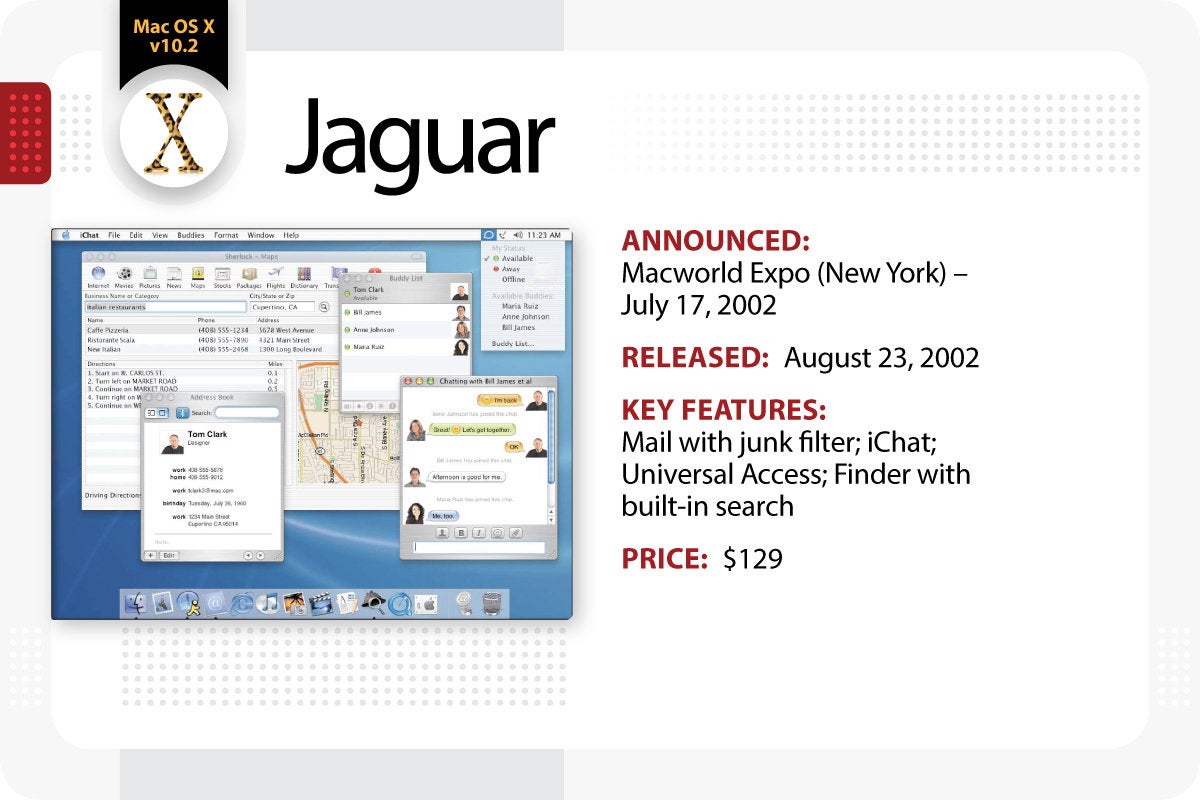
IDG / Apple
Jaguar
While earlier versions of Os 10 did have jungle cat names, they were not used for marketing purposes until Os X Jaguar. Appear at the 2002 Macworld Expo, information technology featured an updated Mail app that placed spam in a junk folder. iChat became Apple'southward default instant messaging app, with congenital-in compatibility with AOL Instant Messenger. Along with a new Finder offering refined search, OS X 10.2 included universal admission for the first time and allowed users to magnify screen contents or launch applications with speech dictation.
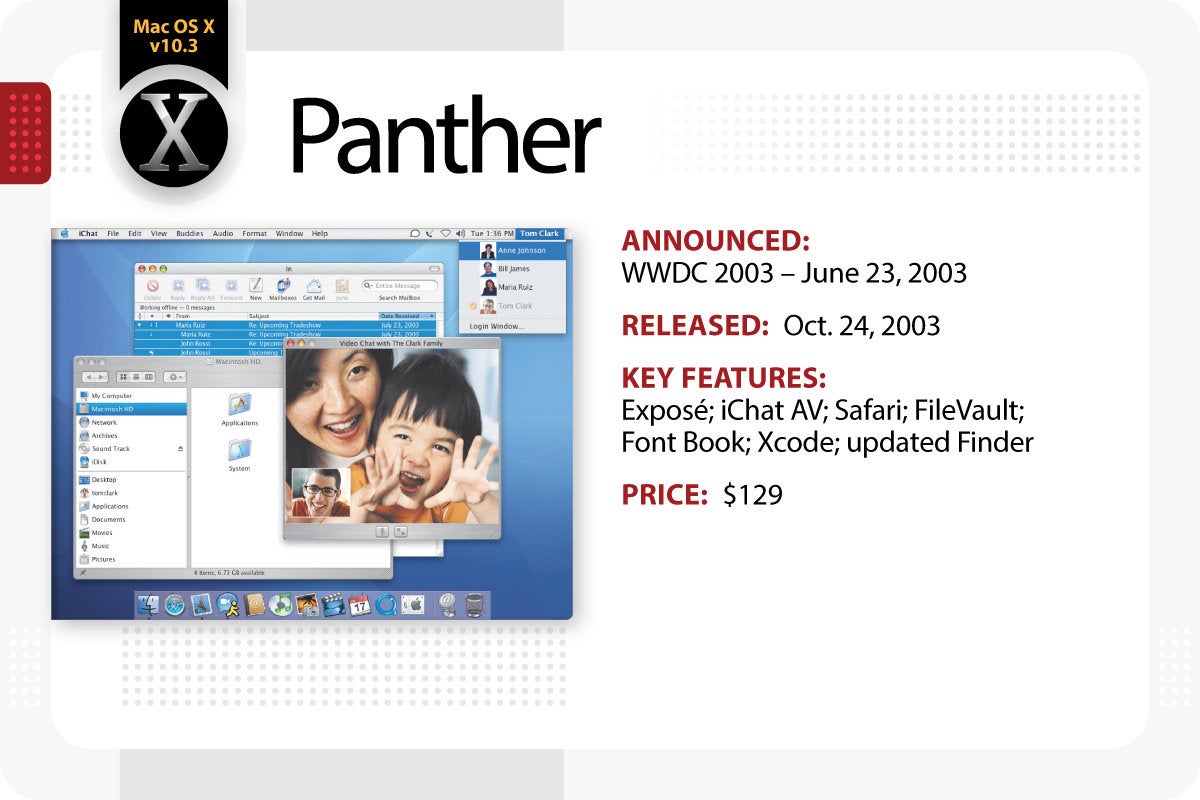
IDG / Apple tree
Panther
Apple announced Bone X Panther at WWDC 2003. It included Exposé, a useful feature that permit users instantly view all open windows at once, view windows of a current programme or only view files on the desktop. iChat AV let users communicate with sound and video besides as text, and Safari became the Mac's default spider web browser after it dropped back up for Internet Explorer for Mac.
Os X 10.iii likewise introduced FileVault to encrypt hard drive data with 128-fleck keys; Font Book, Apple's simplified awarding for managing system fonts; Xcode, Apple'southward programmer tool to build Mac applications; and a revamped Finder with sidebar for easy access to disk drives, networks and folders.
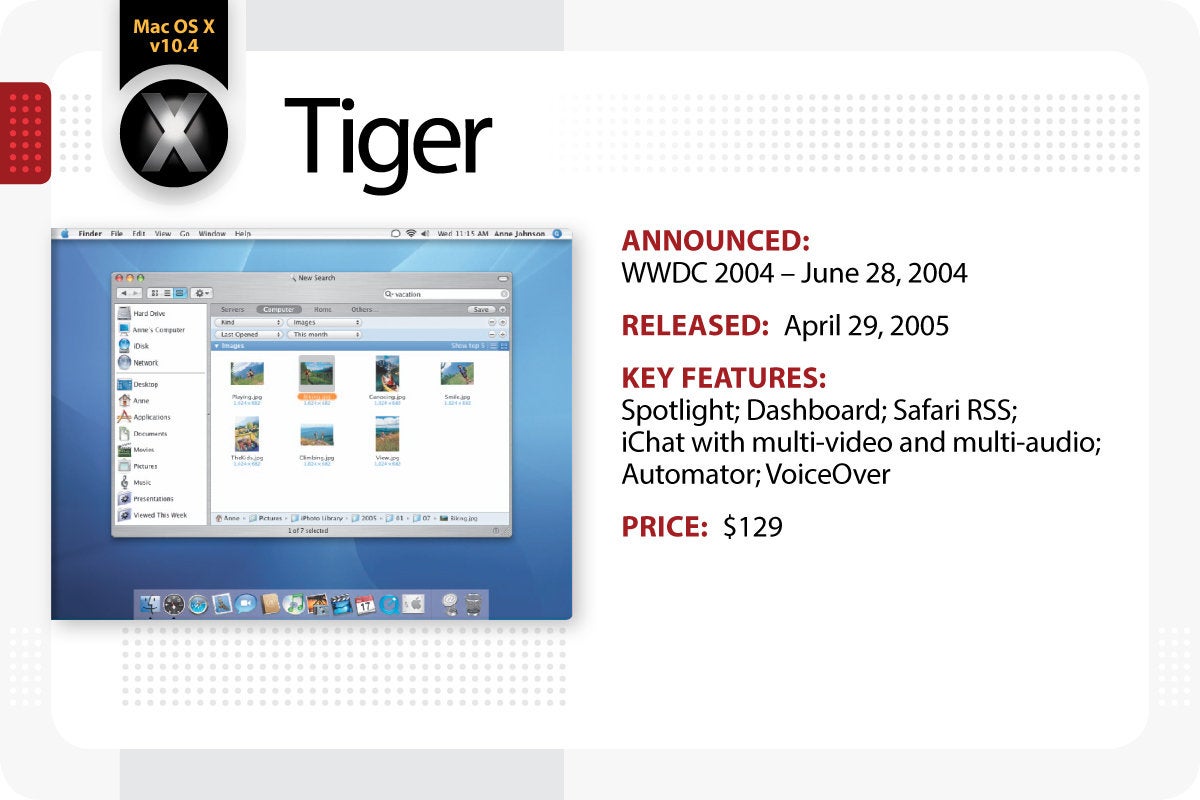
IDG / Apple
Tiger
Os X Tiger was introduced at WWDC 2004. It included a universal search client, Spotlight, which allowed users to search their unabridged system from the menu bar for files, emails, contacts, images, calendars and applications. Dashboard featured widgets for weather, flight data, stock tickers and more. Safari included RSS features and iChat supported upwardly to four participants in a video conference or 10 participants in an audio conference.
OS X ten.4 besides introduced Automator, an application that automated tasks and workflows such as renaming big groups of files or resizing dozens of images; and VoiceOver, an accessibility interface that provided magnification options, keyboard control and spoken English descriptions of what's happening on screen.
OS X Tiger became the first Os to back up the Apple tree-Intel architecture after Apple's transition to Intel x86 processors, and it became the longest running version of Mac OS X prior to Leopard's release 30 months subsequently.
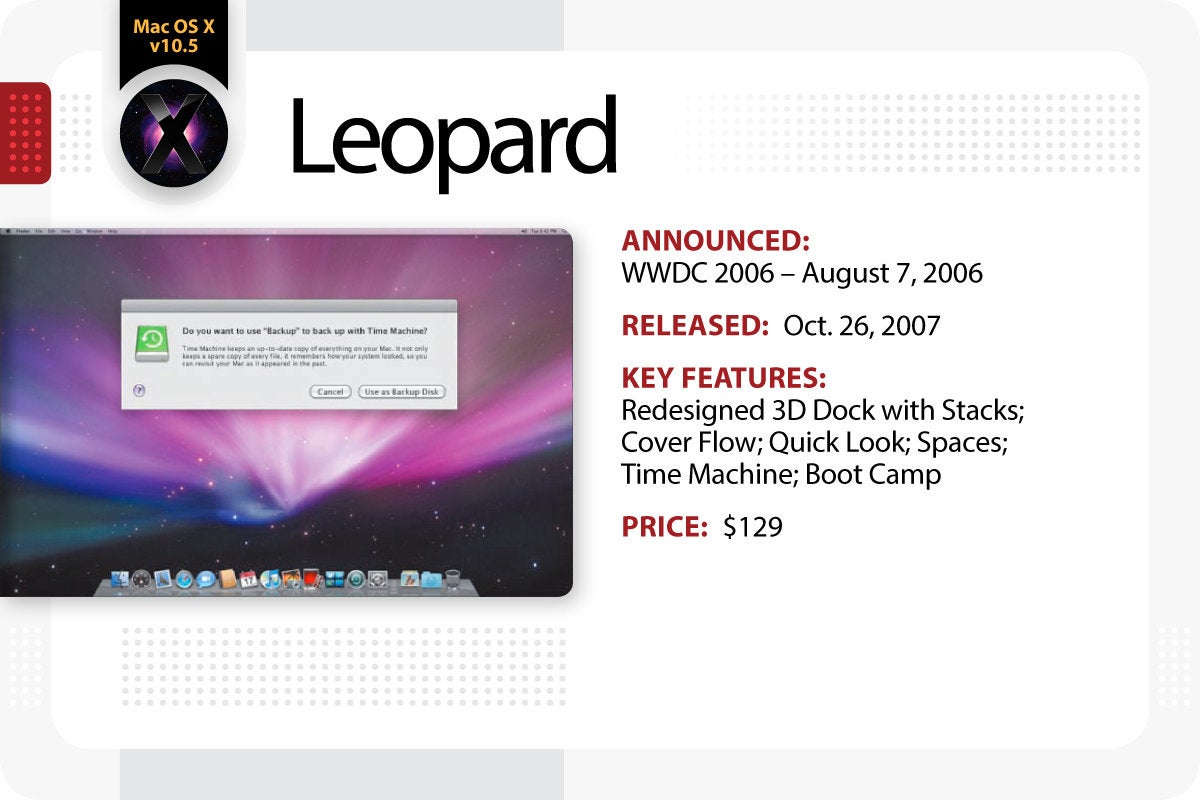
IDG / Apple
Leopard
Apple introduced OS X Leopard at WWDC 2006, and it became a redefining moment for its software, since information technology was noted to be the "largest update of Bone X." It featured a modernized look with a three-dimensional, reflective Dock, a semitransparent carte bar, larger drib shadows for active windows and new high-resolution icons.
Os X x.5 included Stacks, a grouping feature that displays files in a "fan" or "grid" way in folders on the Dock; an updated Finder that incorporates the Cover Flow visual navigation interface showtime seen in iTunes, iPhone and iPod touch; Quick Expect, which allows a "preview" of items by hitting the space bar; Spaces, a way to grouping application windows on more than than 1 virtual desktop; Time Machine, an automatic backup utility that allows users to restore deleted files; and Boot Camp, Apple's software customer to run Microsoft Windows natively on a Mac. With the release of the aluminum unibody MacBook and Macbook Air with multi-touch rail pad, OS Ten Leopard also unofficially supported multi-bear on gestures.
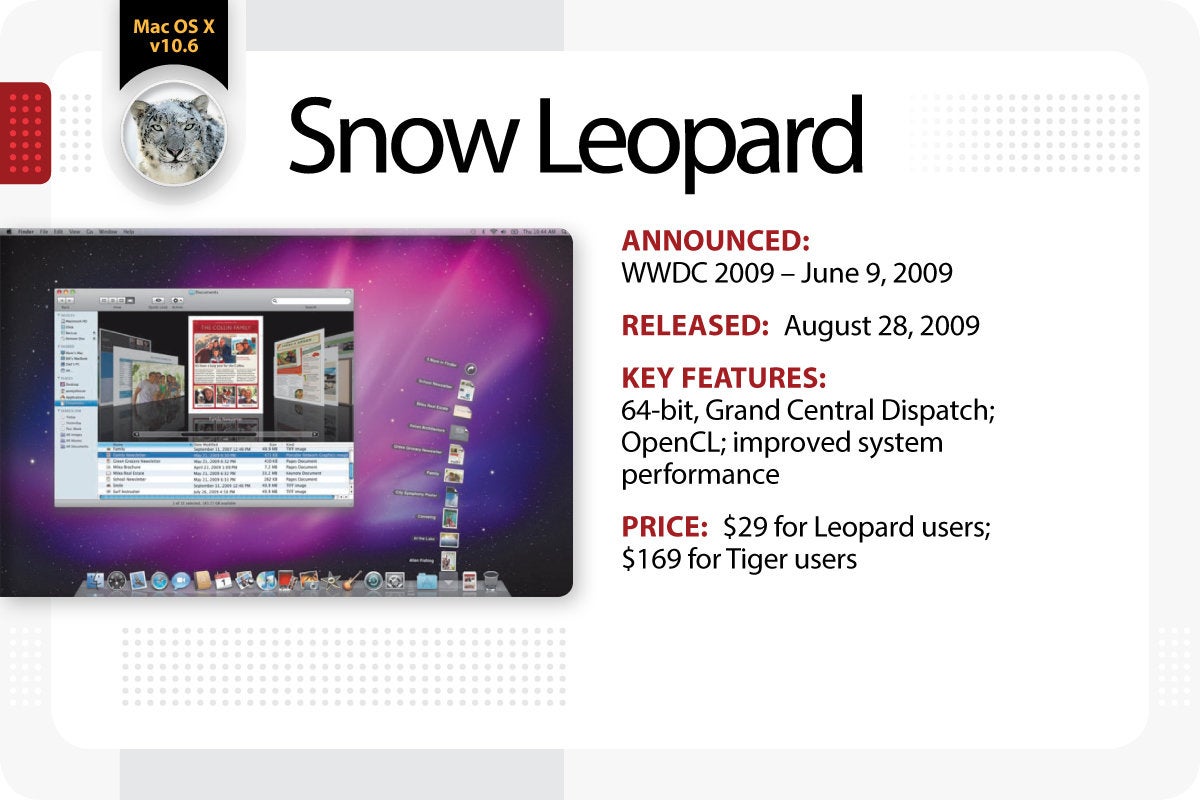
IDG / Apple
Snow Leopard
Bone 10 Snow Leopard was introduced at WWDC 2009, and for the first time, users could buy it for a very affordable $29. This update featured all of Apple's applications rewritten in 64-bit lawmaking; Thou Central Dispatch, a new fashion for software developers to write applications that takes advantage of multicore processors; and OpenCL, a C-based open standard allowing developers to tap into the power of the GPU for tasks that go beyond graphics.
OS X 10.6 too built off of the previous Bone (hence its proper name) with further enhancements such equally faster disk ejecting, quicker Fourth dimension Automobile backup, faster boot and shut down times and faster Os installation. OS X Snowfall Leopard was significantly smaller that Bone X Leapard and freed up to 7 GB of infinite; it also became Apple's first operating system to be Intel-simply. It became the second-longest running Apple OS afterwards Tiger and the last to need a concrete disc after the introduction of the Mac App Store in the Snow Leopard x.6.6 update.
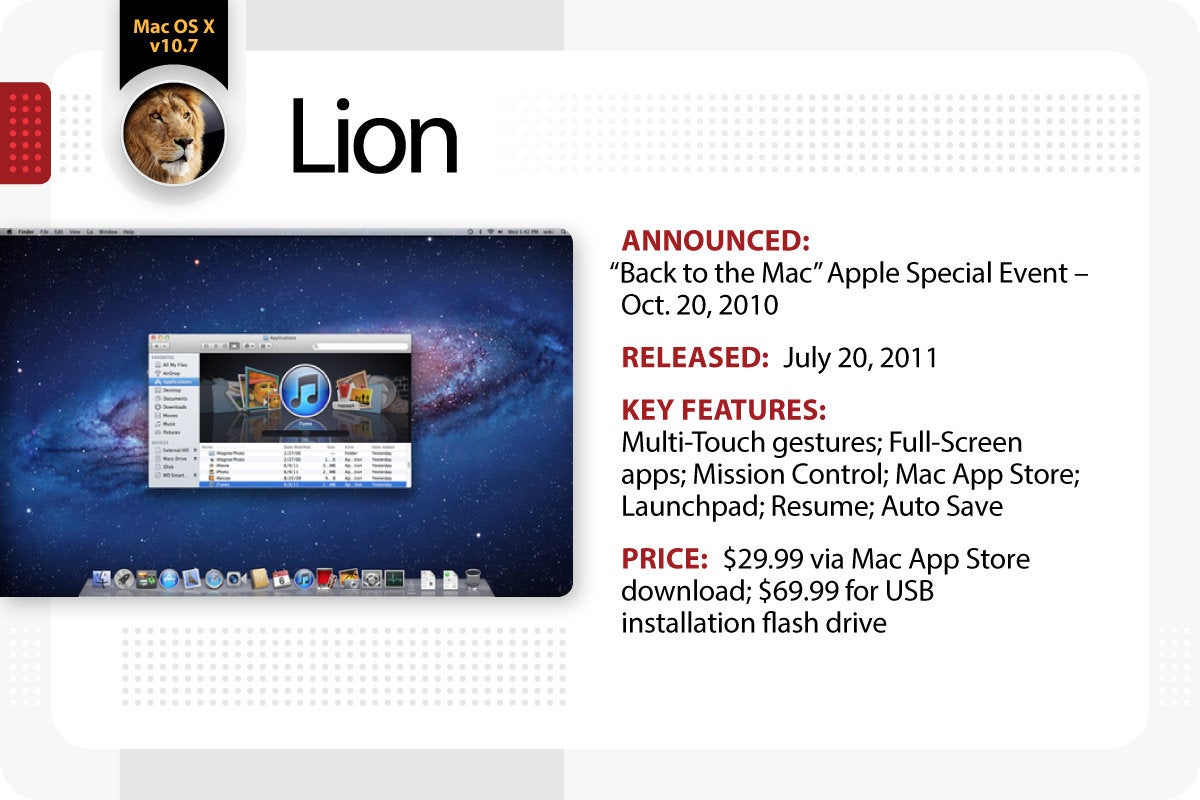
IDG / Apple tree
Lion
Apple introduced OS X Panthera leo at a special upshot called "Back to the Mac." Information technology officially supported multi-impact gestures with added gestures and responses such as rubber-ring scrolling, page and image zoom and full-screen swiping. Apps could be total-screen for the first time, and the introduction of Mission Control combined Exposé, Dashboard, Spaces and full-screen apps to give users ane identify to see and navigate everything running on their Mac.
OS X 10.7 brought many developments fabricated in iOS, such as an easily navigable brandish of installed applications -- Launchpad -- and new thinner, greyness scrollbars that disappeared when non used. Bone X Lion also included back up for the Mac App Store, introduced in OS x.vi.6. Other features included Resume, which allowed apps to reopen if airtight, and Auto Relieve.
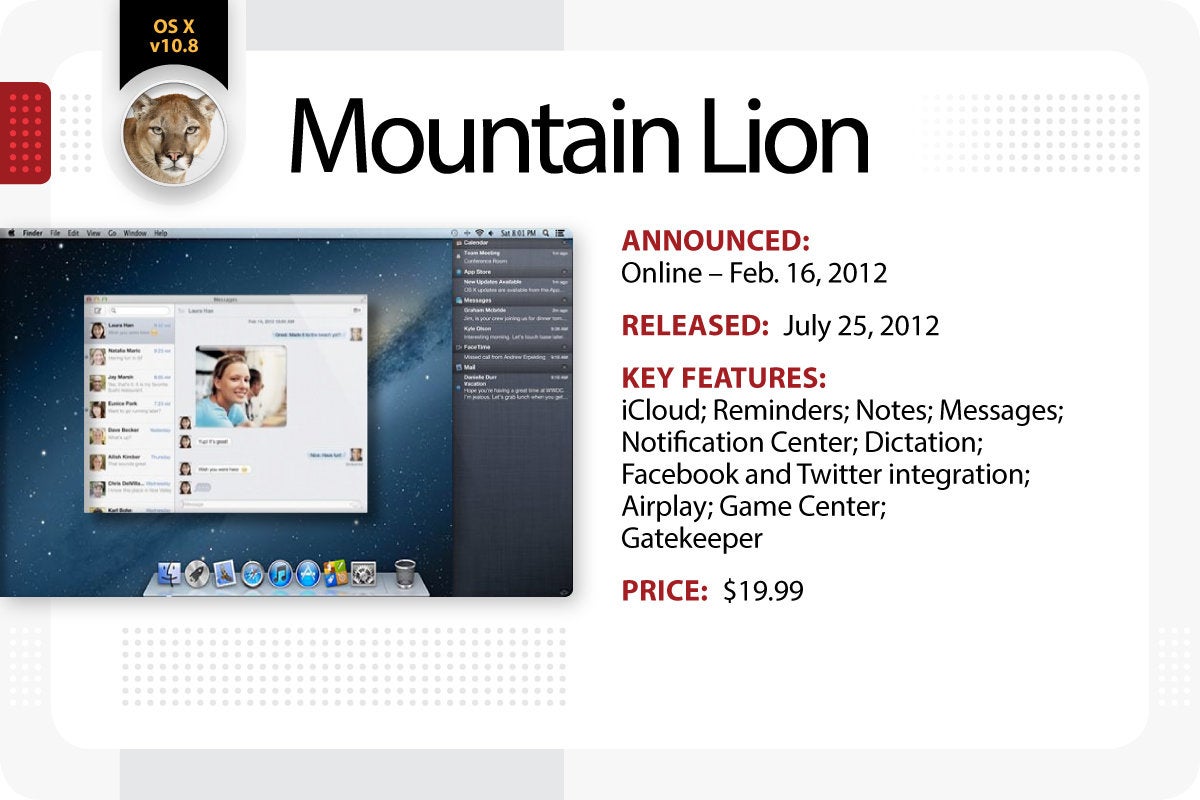
IDG / Apple
Mountain Lion
Apple introduced OS X Mountain Panthera leo at WWDC 2012, and from and so onward dropped the "Mac" prefix from all references of OS X on its website. iCloud synced mail service, calendars, contacts, reminders, documents, notes and more between Macs, iPads, iPhones and iPod touches. Apps from iOS devices were besides brought over: Reminders, Notes and Letters, which brought iMessage to the Mac for the get-go time; Notification Center alerted users to new emails, messages, software updates or calendar alerts; Dictation converted words into text; and a new Sharing button allowed the sharing of photos, videos, files and links with Mail service, Messages and AirDrop.
Os X 10.viii integrated Facebook and Twitter and then users could set up and manage their accounts correct in System Preferences. AirPlay Mirroring enabled easy sharing from a Mac to an Apple TV, and Game Center brought games from iOS to the Mac. Finally, Gatekeeper helped protect users from downloading and installing malicious software to their Macs by only permitting users to install apps from the Mac App Store and other identified developers. Users could download this update for a slimmer price at $19.99.
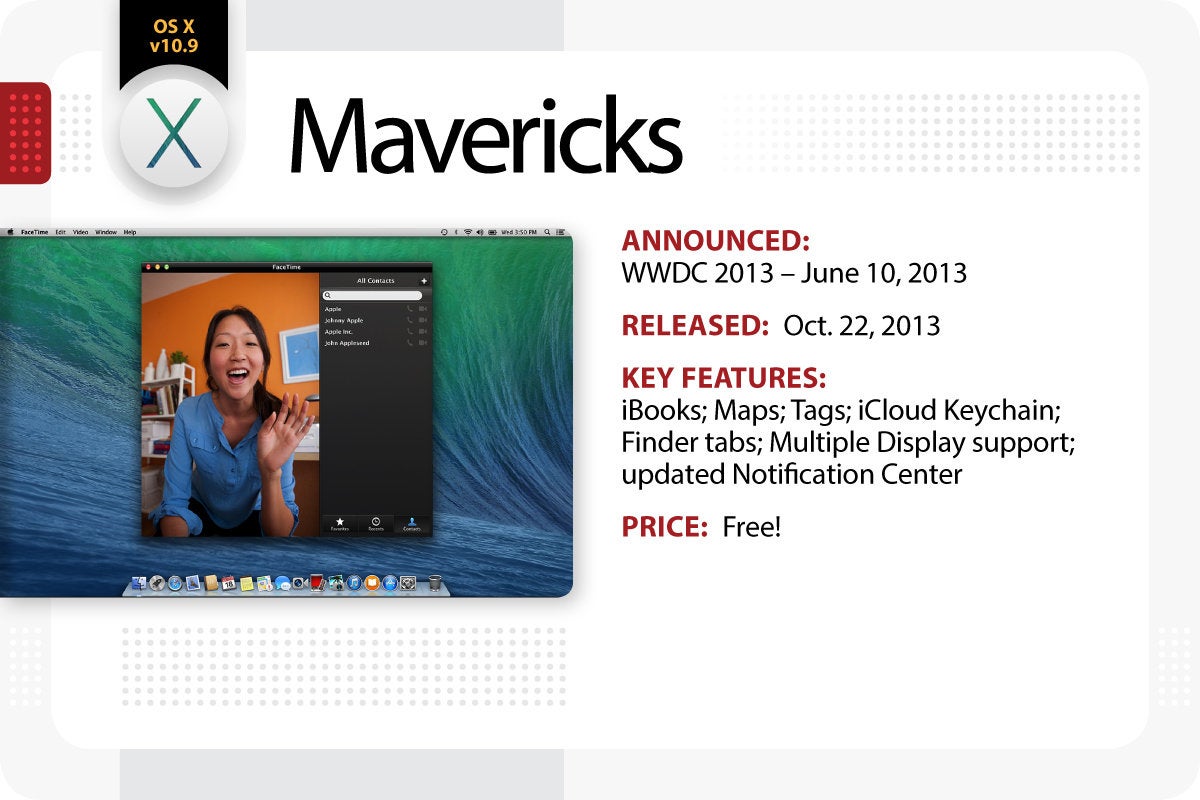
IDG / Apple
Mavericks
Apple tree introduced OS X Mavericks at WWDC 2013. It replaced its big true cat naming convention with places in Apple's home state of California; thus Mavericks was named after a popular surfing spot.
OS X 10.9 introduced iBooks from iPad, Maps from iOS that enabled users to send directions from their Mac directly to their iPhone, and Tags, a new manner to organize and find files by labeling them via colors or particular naming conventions; iCloud Keychain stores, encrypts and automatically enters passwords; the Finder tin can back up tabbed browsing for further productivity and back up for working on multiple displays with menu bars and dock; and Notification Eye allows users to collaborate with alerts, such as replying to an iMessage. Icons were also redrawn double their size for the new MacBook Pro with Retina Display.
For the get-go fourth dimension ever, Mac users could update to the latest Mac Bone for free.
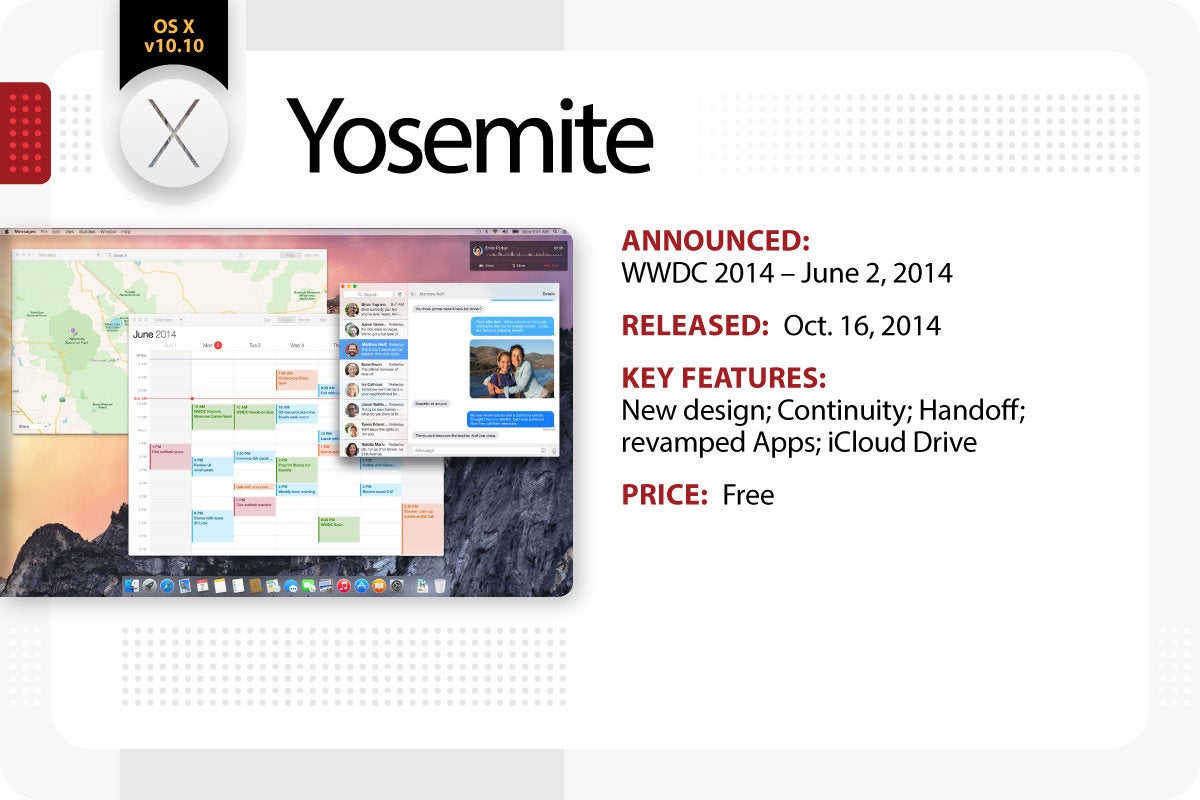
IDG / Apple tree
Yosemite
Apple announced OS Ten Yosemite at . To match the pattern overhaul of iOS vii, Bone 10 Yosemite discarded the skeumorphic interface it had used for over 10 years. The update included a flat graphic blueprint, blurred translucence effects, a two-dimensional Dock that iterated the one used in Tiger, updated icons, lite and nighttime color schemes, and the starting time time ever replacement of the default organisation typeface from Lucida Grande to Helvetica Neue. With Continuity, Macs could at present receive and make calls from an iPhone on the aforementioned Wifi network. Macs could also send and receive SMS text messages, and iCloud synced all iMessages and text messages between a Mac and an iOS device.
OS X 10.10 included Handoff, which immune users to write an e-mail or browse Safari while moving seamlessly from a Mac to an iPhone or iPad and vice versa. The new Photos app replaced iPhoto and integrated photos from iCloud or an iOS device into 1 identify. Mail allowed marker up attachments right in the app, and Postal service Driblet immune users to send large files (upward to 5GB) without having to worry about an email client's limitations. Finally, iCloud Drive let users store all types of files in one place and access them from any device.
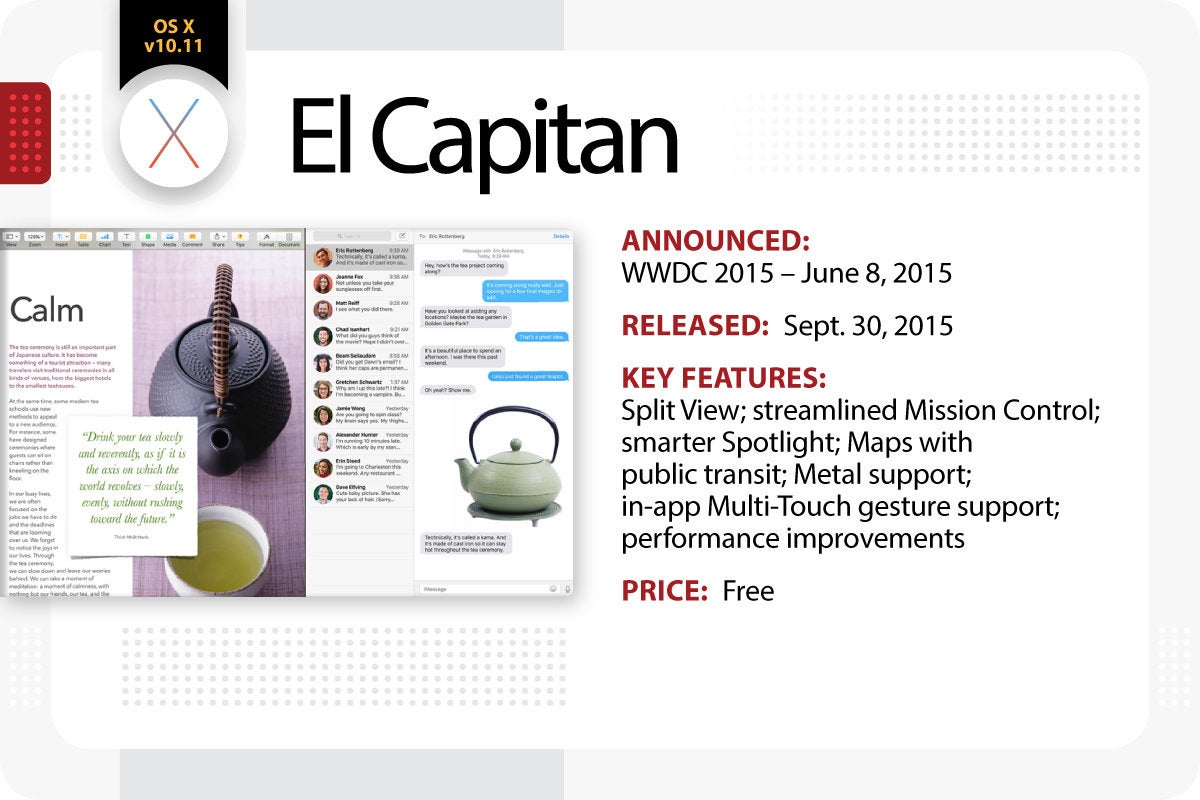
IDG / Apple
El Capitan
OS X El Capitan was announced at WWDC 2015. It enhanced the design and usability of OS X Yosemite with operation and security improvements. Features included Split View, which placed two full screen apps next; a streamlined Mission Command, which made it easier to see all open windows in 1 place; a smarter Spotlight that delivered results for weather, sports, stock, web, video and transit directions and tin deliver information using natural linguistic communication; a refreshed Maps app that included public transit data for some U.Due south. cities; Metal, a new graphics core technology that gave games and apps virtually straight access to the Mac'due south graphics processor for better functioning; in-app Multi-Touch gesture support; and organization-wide performance improvements for farther responsiveness and efficiency when using apps.
A new font chosen San Francisco used on iOS devices running iOS 9 and Apple watches running watchOS besides replaced Helvetica Neue that debuted on Yosemite.
For more than almost Mac Os 10, check out "15 years of Bone 10: How Apple tree's big hazard paid off."
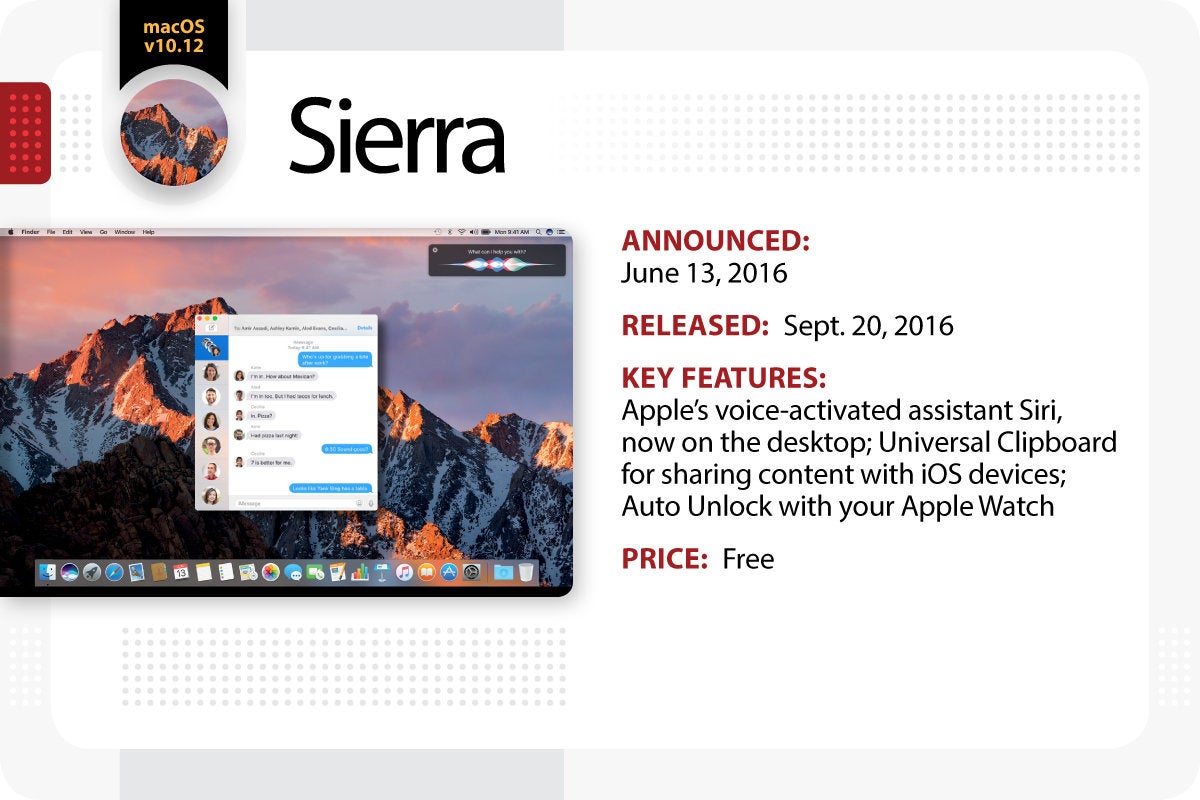
IDG / Apple tree
Sierra
The renamed macOS Sierra debuted at WWDC 2016 and later a public beta plan over the summer rolled out in finished form on Sept. xx. Sierra brought a variety of changes, near notably the arrival of Siri on the Mac desktop. Users could admission Siri in the upper right-hand corner of the carte du jour bar between the Notification Centre and Spotlight carte icons, a Dock icon, the menu bar icon or a hot key. The vox-activated assistant could assistance users find files, get quick access to data like the weather or perform searches, with search results that could be saved and pinned to the Notifications area. Other changes in Sierra included a Universal Clipboard, which allowed text to be copied from i Apple device to some other; iCloud Desktop and Documents, for syncing data across Macs using the cloud; Auto Unlock, which allowed the Apple Picket to unlock a macOS account; and Apple Pay on the spider web. Photos received a new Memories characteristic that automatically created curated collections of users' favorite photos and videos. Sierra as well delivered more than than 60 security fixes.
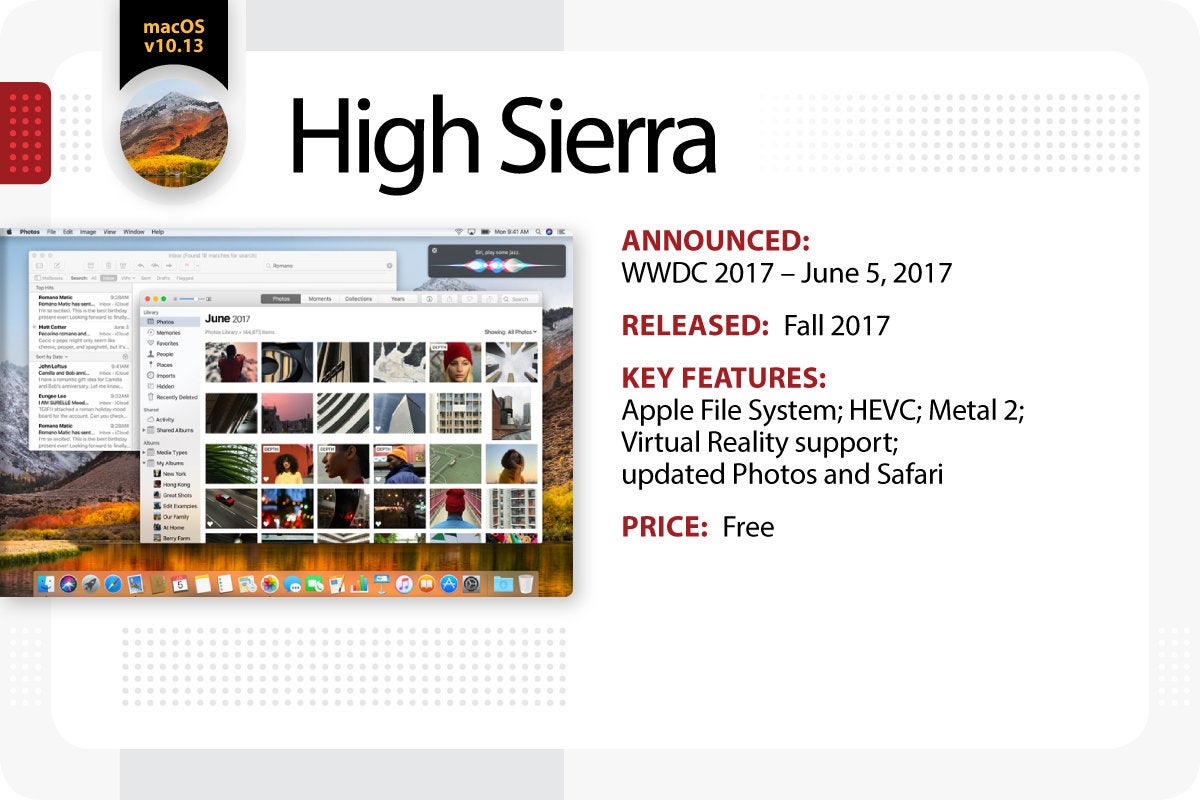
IDG / Apple tree
High Sierra
Introduced at WWDC 2017, macOS High Sierra is an iterative update to macOS Sierra, and its name is an ode to California's Sierra Nevada mountains. This version introduces Apple File Arrangement to efficiently manage data for meliorate performance every bit well as a new manufacture standard for 4K video -- High Efficiency Video Coding, also known equally HEVC or H.265. Metallic two furthers graphics capabilities and tongue processing, and developers will be able to create interactive virtual reality experiences on a Mac for the get-go time. A refreshed Photos app makes searching for and organizing photos easier and contains advanced editing tools. Safari becomes faster and contains new features like Intelligent Tracking Prevention to remove cross-site tracking information from advertisers. Safari also automatically disables those annoying autoplaying videos with audio for a quieter browsing experience. Other features include improved Siri and Spotlight and instant iCloud syncing for Letters. It will be available as a free download on Sept. 25.
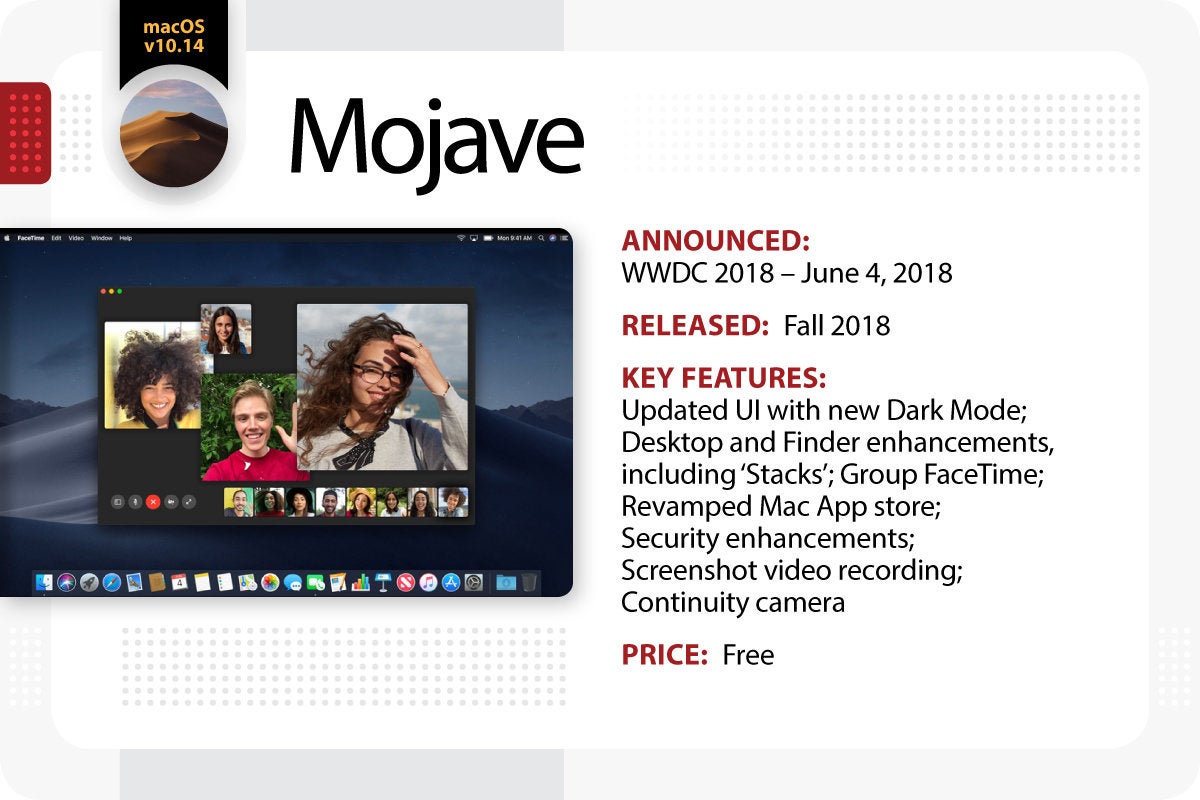
IDG / Apple
Mojave
Apple announced macOS Mojave at WWDC 2018. Its main feature is a new Dark Style that turns the overall UI dark greyness. (A new interactive wallpaper tin also adapt to the fourth dimension of twenty-four hours based on a user's location.) The new Stacks characteristic organizes cluttered desktops by automatically stacking like files into groups, and Gallery View – reminiscent of Cover Menses – lets users visually skim through files. Preview Panes show file metadata, and Quick Look allows users to rotate, crop and mark up PDFs and trim video clips without opening native applications. The News, Stocks, Vocalisation Memos and Dwelling house apps from iOS arrive on the desktop; Group FaceTime allows upwardly to 32 users on a simultaneous video chat; and the Mac App Store gets a fresh design. Security enhancements via Safari's Intelligent Tracking Prevention block user tracking without permission. The screenshot tool contains new on-screen controls to mark upward images and allows users to record video. Continuity Photographic camera permits users to take a picture or scan a certificate with an iPhone or iPad and take information technology appear instantly on their Mac. Integrated markup tools for Finder, Quick Wait and Screenshots too brand calculation comments fast and easy. macOS Mojave volition exist bachelor this Fall as a free update for Macs introduced in mid-2012 or later and for 2010 and 2012 Mac Pro models with recommended Metal-capable graphics cards.
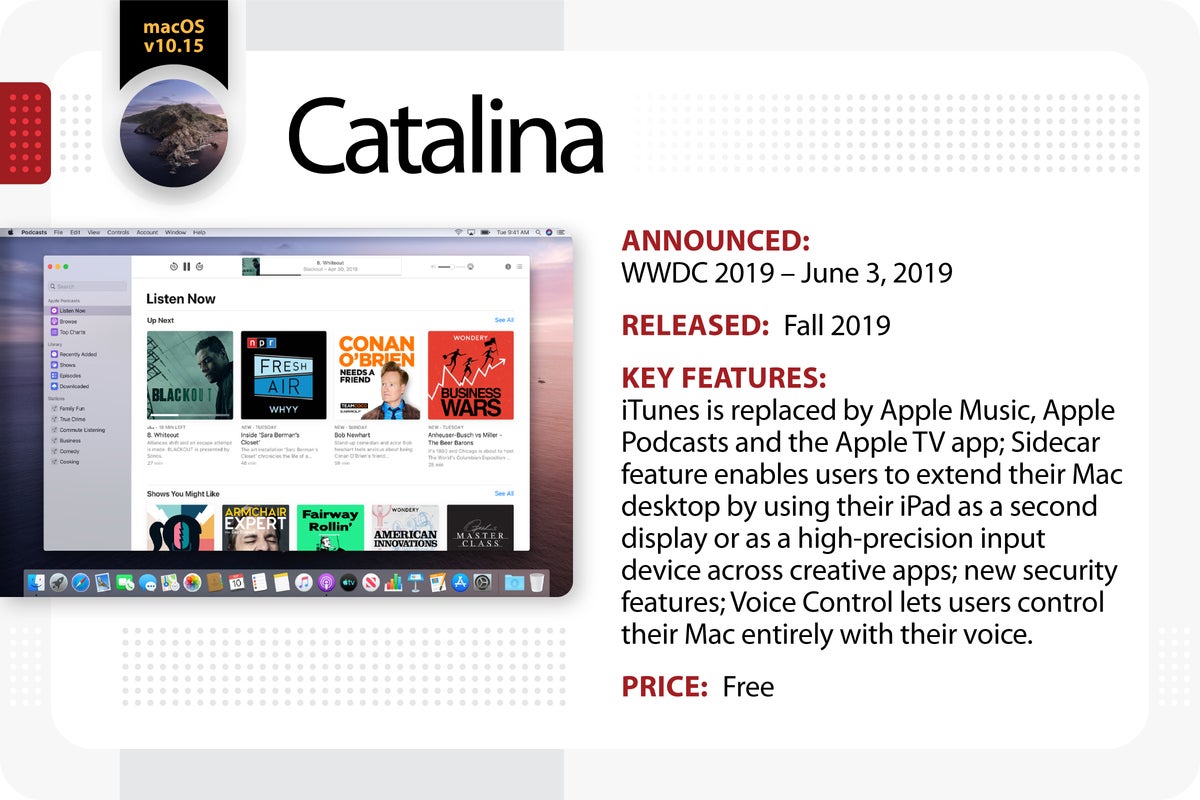
IDG / Apple
Catalina
With macOS 10 (Catalina), Apple tree is making a push button to draw gamers to the company's desktops with Apple Arcade, a game subscription service that costs $iv.99 a calendar month. Apple tree likewise is rolling out new desktop versions of several of entertainment apps: Apple Music, Apple Podcasts, and Apple Goggle box to assistance users find the content they want to listen to or spotter. For workplace Mac users, Catalina adds a new feature called Sidecar that's designed to extend the Mac desktop to the iPad. With Sidecar enabled, the tablet becomes an input device (using Apple Pencil). And with new Voice Control features, Apple is turning to Siri to let users to operate their Macs with vocalism alone. For developers, Apple tree introduces Mac Goad, which allows them to build macOS versions of iPad apps. And for the security-conscious, Apple has made a number of under-the-hood improvements, including a read-but system volume to help prevent data loss; Gatekeeper to limit the possibility of malware and dangerous app downloads; and Activation Lock, which allows a user to erase a Mac if it is lost or stolen. macOS Mojave will exist available in the Fall for free. It drops support for 2010-12 Mac Pro models and now requires 4GB of RAM.
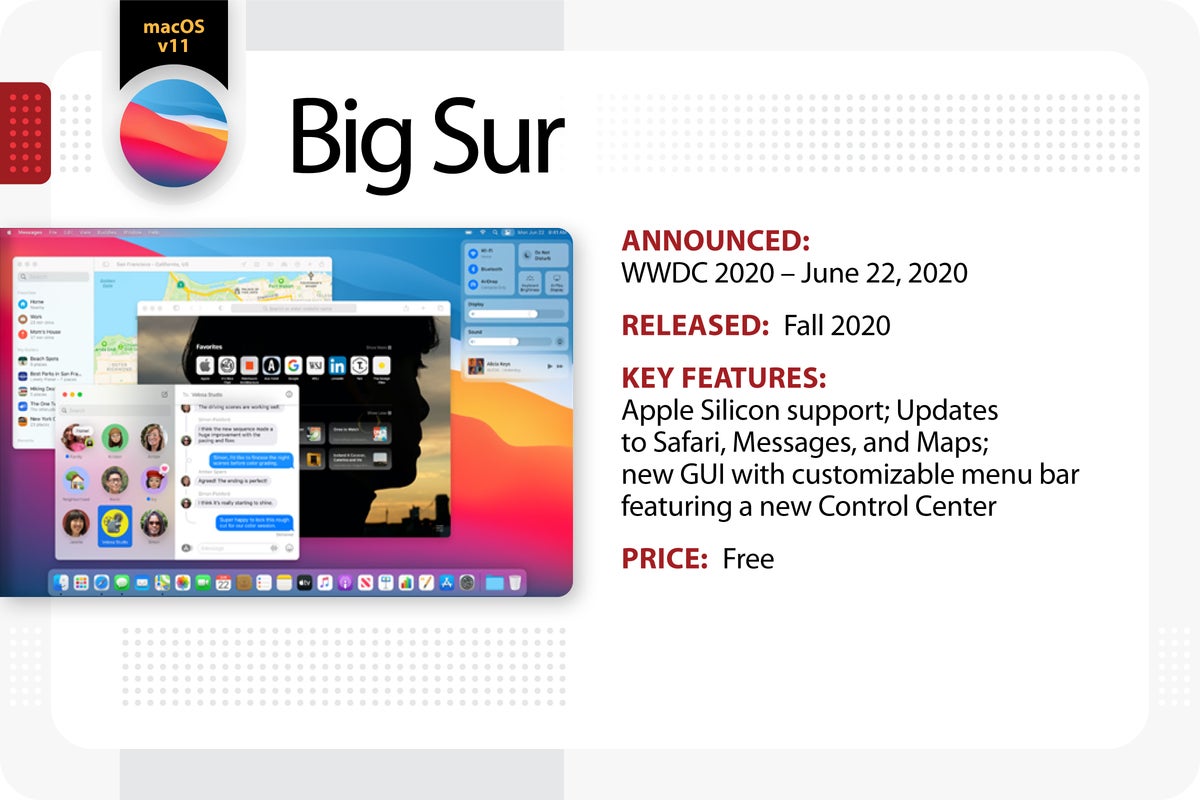
IDG / Apple
Large Sur
The big news with macOS 11 (Big Sur) is less virtually the operating system and more virtually the hardware that will run it: Macs using Apple'southward Apple tree Silicon chips. At WWDC '20, the visitor unveiled plans to transition all of its hardware to its own processors within two years — and said Big Sur will be the first version of macOS to run on the new fries. Equally for Large Sur itself, information technology gets a UI redesign that includes curved windows, redesigned Dock icons, a new Command Center (accessible from the menubar), a redesigned Notification Heart, upgrades to make the Safari browser faster and more customizable, more than "personality" for Letters, and an overhauled Time Machine fill-in system. Apple stressed that Big Sur would utilize technology — dubbed "Rosetta 2" — that would make it possible to run apps designed for Intel chips on new hardware using Apple Silicon. Big Sur drops support for some older Macs (mainly released before 2013) and will be available this Fall free of charge.
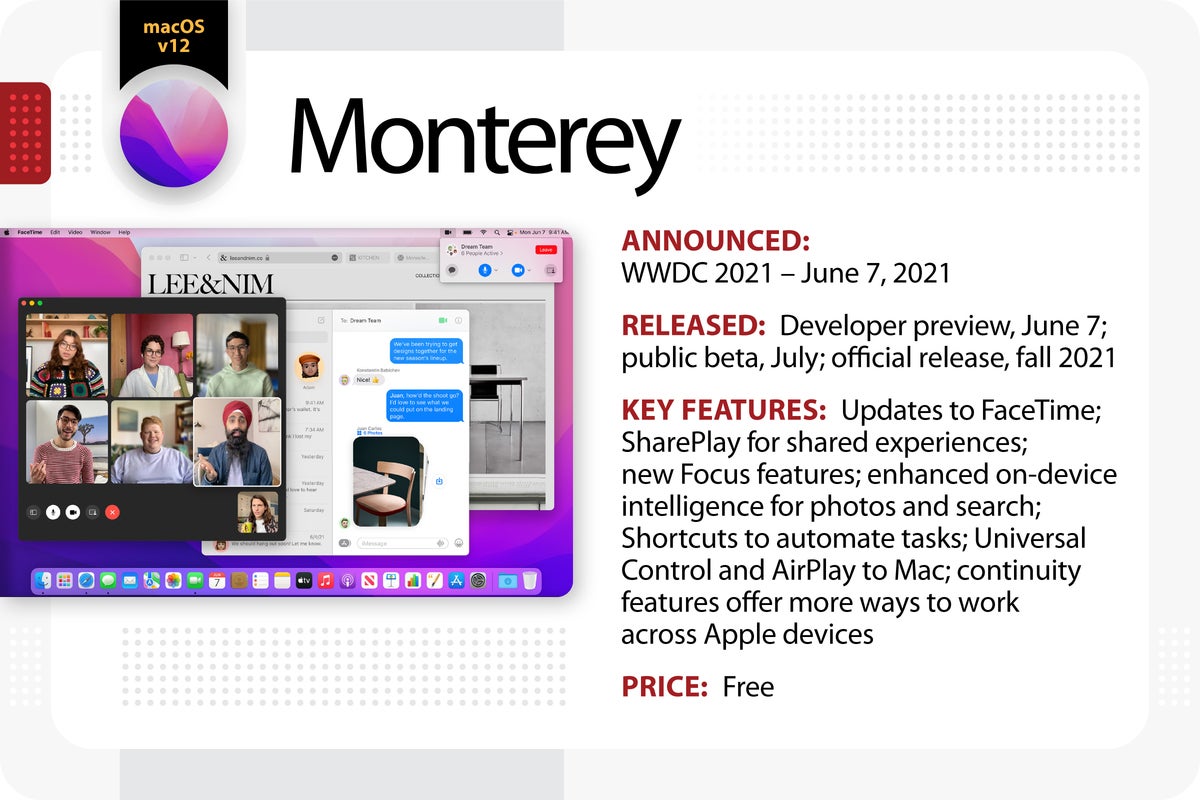
IDG / Apple tree
Monterey
macOS 12 (Monterey) offers a multifariousness of changes aimed at making it easier for Mac users to connect online and stay focused on what they're doing on the desktop. Safari gets an overhaul that moves tabs high in the browser window, finer combining tabs, the toolbar, and the search field, and allows users to create tab groups that tin can be shared. Monterey besides gets Shortcuts, which helps users automate tasks and is integrated throughout the OS. FaceTime gets a slew of new features, including Vocalism Isolation (to go far easier to hear people on a video phone call) and Wide Spectrum (so callers can hear everything, not simply a person's voice); SharePlay, so multiple people in different locations can collaborate on work, or even lookout man the same flick and chat about it in real-time; blurred backgrounds; and a new filigree view. And with the rollout of Universal Control, users tin work with a single mouse and keyboard and movement betwixt a Mac and and an iPad seamlessly, no setup required. Apple also previewed iCloud+ features focused on better security and privacy and Live Text, which uses machine learning to notice information in pictures such equally phone numbers and addresses that can exist used in other apps. Monterey arrives in the Fall as a free upgrade. It drops support for older Macs made before tardily 2014 (though it works on the 2013 Mac Pro).
Copyright © 2021 IDG Communications, Inc.
Where Can I Download Os X El Capitan,
Source: https://www.computerworld.com/article/2983507/the-evolution-of-macos-and-mac-os-x.html
Posted by: cunninghamferse1978.blogspot.com


0 Response to "Where Can I Download Os X El Capitan"
Post a Comment